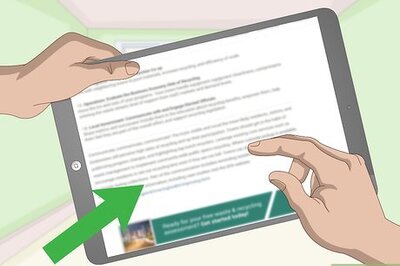
views
Prime Minister Narendra Modi recently unveiled a new vision for his pet project the GIFT City on the outskirts of Ahmedabad, launched in 2011, to become a financial capital to rival Mumbai. Addressing the Infinity Forum, a global thought leadership platform on fintech via video conferencing, Modi talked about breathing a fresh life into the project.
A masterplan for expansion of GIFT City to over 3,300 acres along with vibrant social infrastructure is in the final stages of completion. It is likely to be submitted to the Gujarat government’s Urban Development Department in the next few weeks.
“GIFT City envisioned as a dynamic ecosystem that will redefine landscape of international finance. We want to make GIFT City the Global Nerve Center of New Age Global Financial and Technology Services,” the PM said.
What is GIFT City
Nestled in the Gandhinagar district, GIFT City, envisioned in 2007, and launched in 2011, stands as India’s pioneering greenfield smart city. This specialized economic zone aims to offer top-notch infrastructure and services tailored for financial institutions and companies involved in banking, insurance, capital markets, and asset management.
The city is a bustling hub, predominantly hosting banks, capital market entities, insurance firms, and captive manufacturing units. Presently, it hosts over 20,000 employees representing 400-plus companies, including Oracle, Bank of America, Cyril Amarchand Mangaldas law firm, Citibank, State Bank of India, Bombay Stock Exchange, and the National Stock Exchange. GIFT City also features a commodity bourse and a bullion exchange. It boasts an impressive average daily turnover of $4 billion.
The city is designed as a ‘smart city’, featuring residential complexes, schools, hospitals, business clubs, and hotels. It also boasts essential infrastructure such as a wastewater recycling plant.
The vision behind GIFT City was to outmaneuver Mumbai as the choice of venue for a new tax-neutral financial centre for banks, exchanges and investment funds. So far, it has struggled to achieve that goal. But those struggles could be a thing of the past soon.
A New Lease of Life
PM Modi sees GIFT City evolving beyond its fintech strength to become a global center for climate financing. This aligns with India’s ambitious goal to achieve net-zero emissions by 2070, which requires a massive investment of around $10 trillion, largely from global sustainable finance sources. There’s a focus on developing innovative financial products like green bonds and sustainable bonds. The International Financial Services Centres Authority (IFSCA) is instrumental in driving GIFT City’s development as a hub for sustainable finance.
Other regulatory changes being mulled include allowing direct listing of Indian firms on foreign exchanges at GIFT City. A notification in this regard is likely very soon, as per Moneycontrol. V Balasubramanian, Chief of NSE’s International Exchange in GIFT City, notes that this development allows Indian companies to raise funds in dollars without needing to list on more expensive foreign exchanges. Foreign brokers will also be permitted to trade on GIFT City exchanges without a physical presence. National and foreign exchanges in IFSC enjoy total tax exemption from various taxes.
Talks are ongoing with about six technology companies for potential direct listings. The two operational international exchanges at GIFT City — BSE’s India INX and NSE’s International Exchange — will be merged by January-end according to IFSCA chairperson K Rajaraman. More regulatory changes are also likely to come into effect from April.
Benefits Galore for GIFT City Investors
Investors in GIFT City already benefit from a range of incentives and advantages. These are likely to go up further as the Centre tries to make it an attractive destination. Tax benefits are significant, including no Minimum Alternate Tax (MAT) or Alternate Minimum Tax (AMT) for companies under the new tax regime, a tax holiday on capital gains for aircraft leasing companies, exemption from tax on aircraft lease rentals, and no Goods and Services Tax (GST) on services. In fact, Indigo has announced plans to set up its first aircraft leasing office in GIFT city soon.
The business advantages in GIFT City are considerable. Banks can use branches for foreign borrowings of Indian companies at a reduced withholding tax rate. Companies also reportedly can achieve about a 20% reduction in operating costs through incentives like EPF reimbursement, lease rental subsidy, and power subsidy from the Gujarat state. State government subsidies like complete reimbursement of stamp duty, registration fees etc further enhance the appeal.
Attracting Global Wealth
Minister of State for Electronics and IT Rajeev Chandrasekhar says that, following the Silicon Valley Bank’s collapse, approximately $200 million out of the nearly $1 billion was transferred from SVB to GIFT City accounts by Indian companies as of March 17, 2023.
Moreover, Saudi Arabia has shown interest in setting up an office of its sovereign wealth fund in GIFT city. Saudi Arabia plans to invest a $100 billion in India, although there is no timeline attached to it.
Making of a Liveable GIFT City
Over the years, GIFT City has created unmatched business and job opportunities with its efficient regulations, plug-and-play infrastructure, access to the large Indian hinterland economy. However, it has struggled to live up to its dream about being a vibrant city where residential complexes co-exist with corporate buildings.
Out of an estimated 20,000 people who work in GIFT City, only a little over 1% live within the campus.
GIFT City has faced concerns regarding the lack of entertainment and social life, which has been a deterrent for young professionals considering relocation. While myriad schools have come up, a lot of infrastructure needed to sustain residents is still lacking.
Recognising the issue, the proposed master plan aims to make the city more vibrant and attractive. Housing projects are a key part of the attempt to get people to live in the campus, and work is on for 4,100 flats ranging from the fancy to the affordable. There is also a hospital under construction. The hope is that once the high-end housing units come up, they will help infuse evening life into the city, which is usually dead by sunset.
A 9-km long riverfront on the Sabarmati River is projected to be completed within the next 2.5 years and will feature extensive entertainment, recreational, and retail zone. Some other attractions being built include a Ferris wheel bigger than the London Eye, to increase tourist footfalls. One other major initiative is the activation of the Metro network, which is scheduled to be operational by July 2024.
Furthermore, the GIFT City board is pushing forward with the Fintech Tower Initiative. This involves constructing a dedicated tower that will house fintech training institutions, start-ups, and research and development facilities.
As Prime Minister Narendra Modi continues his vigorous focus on bolstering India’s economic prowess on the global stage, his recent involvement in reinvigorating the development of GIFT City represents an important next chapter for the ambitious project. Over a decade since its inception under Modi’s guidance as Gujarat CM, the financial hub is implementing advances that better capitalize on early foundations and align its vision with evolving national priorities.



















Comments
0 comment